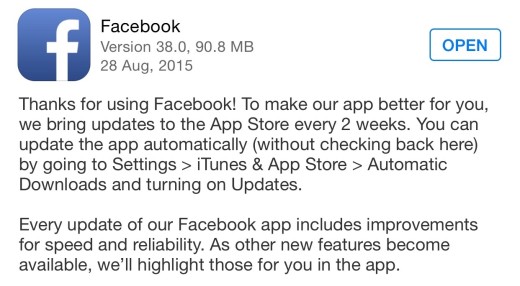
App changelogs used to be simple – they showed you what was new in the latest update. But now developers have fallen victim to trends that make them at best less useful, and at worst completely useless.
Here are the trends ruining changelogs:
1. The bland boilerplate announcement
Facebook is a chief offender here, but Uber and Twitter are among the others often guilty. You know the type of thing: “We’re always improving our app and bring you regular updates.” Okay, but come on – are there bug fixes? Has a yellow button turned purple? Have you completely changed the UI?

The rise of A/B testing in mobile apps has seen this type of changelog become popular, as developers don’t need to give away everything they’re testing or disappoint users who don’t get to see an interesting test.
2. The changes from an old update
Sometimes developers won’t update the changelog at all, and will keep old changes listed in subsequent updates until there’s something big enough to bother writing something about. This week Twitter pushed out an iOS update that turned the whole interface white, but the changelog talked about long DMs, a feature that had rolled out to all users last week.

3. The jokey update
My colleague Nate Swanner has already railed against these. Medium and Tumblr are notable proponents of this type of changelog, but others do it too.
While it’s fun to see a well-written, creative changelog that breaks from the norm of a bullet-point list, too many of them smell of ‘me too, I want to be funny too!’ or are used as publicity tools. Tumblr actually pitched press to write about a recent iOS changelog.
Back to basics
The introductions of auto-updating of apps on iOS and Android has led developers to treat changelogs for apps like either a chore or an easter egg for those who bother to look. But not everyone auto-updates – some of us like to know what we’re getting into before we run changes on an app we use a lot.
App store operators add a changelog field to let users know what is different in the new version of an app. The least developers can do is comply.
This article originally appeared in the TNW Weekly newsletter. Sign up to get it in your inbox for free, every Friday.
Get the TNW newsletter
Get the most important tech news in your inbox each week.








